MARIAN SHRINES
Seven Monuments to Mary
Cathedral shrines offer artistic reflection on her model of discipleship
By Christina Gray
Lead writer, Catholic San Francisco
Like many great cathedrals throughout the world, San Francisco’s was built to honor Mary’s unique role in God’s plan for human salvation. Her model of discipleship as expressed in Scripture offers inspiration to all Christians and is the unifying theme of the seven Marian shrines of St. Mary’s Cathedral.
While older churches were built with devotional alcoves and side chapels and altars, St. Mary’s Marian shrines are set like jewels around the perimeter of the cathedral interior, inviting visitors into public reflection and prayer. The openness of the shrines in the sanctuary reflects the communal spirit of prayer established by Vatican II.
Archbishop John R. Quinn, Archbishop McGucken’s successor, turned to the Italian artist who had created the majestic sculpture over the entrance to the cathedral, and commissioned Enrico Manfrini to design the first of the 1.5-ton bronze sculptures, each depicting scriptural passages in which Mary played a central role. The shrine sculptures were completed and installed, one at a time, between 1981 and 1996. They are anchored to the walls of the niches by custom-designed structural supports that create an ethereal, “free-floating” effect over simple kneelers.
Our Lady of Guadalupe
This is the most prominent, and undoubtedly the most visited, shrine at St. Mary’s Cathedral. Pilgrims from around the globe, especially those with origins in the Americas (Our Lady of Guadalupe is known as the patroness of the Americas) pray to the “Queen of the New World” and lay flowers at her feet year-round.
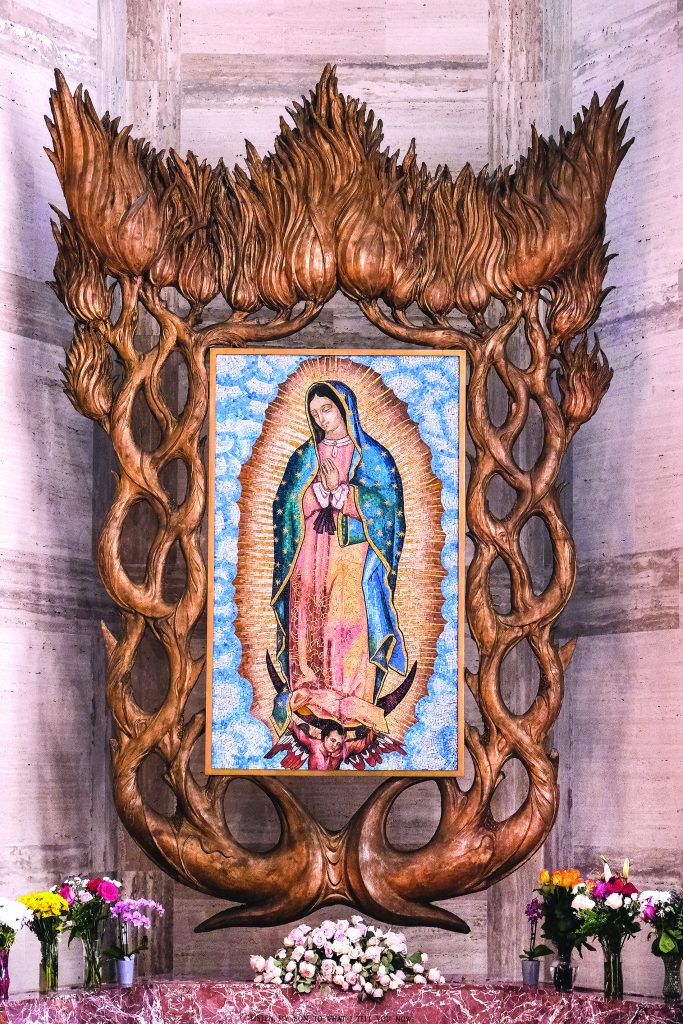
According to sacred tradition, Mary appeared to Aztec Christian peasant St. Juan Diego in 1531, 10 years after Mexico’s conquest by Spain. She appeared as an expectant mother of mixed race, signaling her protection for subjugated people. She is venerated by the large Latino-Hispanic population of the Archdiocese of San Francisco, and others, who process together through the city to the shrine during the annual Cruzada Guadalupana (Guadalupe Crusade).
The sculpture’s central panel is a traditional Mexican mosaic by artist Jorge Rodriguez Moreno surrounded by a bronze frame designed by Manfrini. The sculpture depicts the “burning bush” encountered by Moses on Mount Sinai, a foretelling of Mary, who was able to carry God incarnate within her without being consumed by his glory.
From the plaque: “Listen, my son, to what I tell you now. Do not be troubled or disturbed by anything. Do not fear illness, nor any other distressing occurrence, or pain. Am I not your mother?”
The Visitation
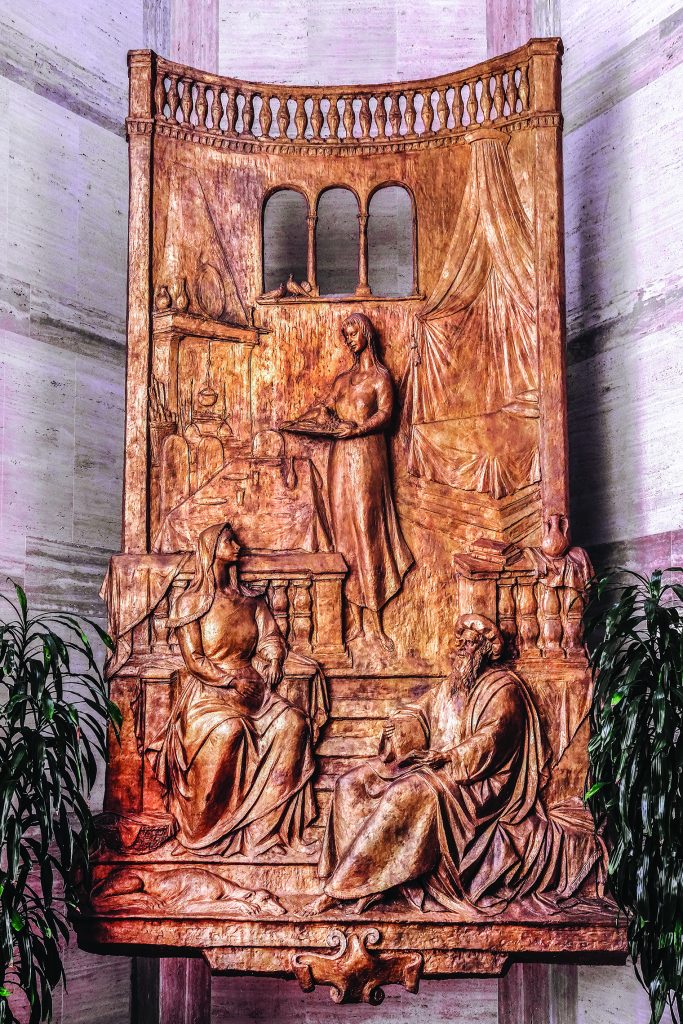
LK 1: 39-56
This shrine depicts the three months Mary spent at the home of her cousin, Elizabeth, who was with child at an advanced age. Her son is St. John the Baptist. Manfrini’s depiction is different than other common scenes of the Visitation, which simply portray the meeting of the two women. Here, Mary is seen serving the household of Elizabeth and her husband, Zechariah. She waits on the elderly couple while she herself is with child.
From the plaque: “Mary is carrying the King of Kings in her womb, but Jesus has come not to be served, but to serve. This shrine invites us to find Christ and to bring Christ into every aspect of daily life.”
The Flight into Egypt
MT 2: 1-23
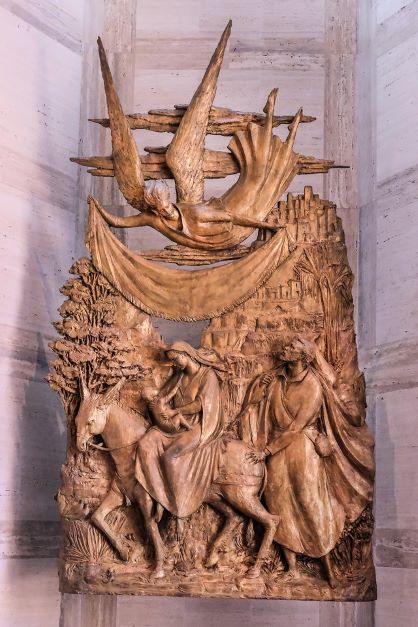
No sooner is Christ born than the shadow of the cross falls. The Holy Family is forced to flee their home in Bethlehem to Egypt in order to escape a plot by King Herod to kill the child. In Manfrini’s sculpture, an angel holds a mantle over the exiled family, a symbol of God’s protection, while Mary cradles her child. Joseph follows behind the donkey, a statement by the artist to show that it is God, not he, who leads them on their journey. This scene from the infancy of Christ was considered especially appropriate for a new cathedral in the United States, where many have found safe refuge from violence, persecution and poverty in their home countries.
From the plaque: “Trusting in God’s providence, symbolized here by the angel, Mary and Joseph follow where God leads.”
The Wedding Feast at Cana

Jn 2: 1-23
This shrine is one of two sculptures at the back of the cathedral designed by Mario Rudelli, a protégé of Manfrini. Rudelli’s bold, energetic style is a complement to the more delicate, ethereal lines in Manfrini’s work. The shrine depicts the first miracle by Jesus in his public ministry. As wedding guests in Cana, Mary calls Jesus’ attention to the fact the wine has run out. Jesus initially declines his mother’s entreaty, telling her that his time had not yet come. He is ultimately moved to act by his mother’s faith as his disciple.
From the plaque: “Christ responds to her deep faith and changes the water into wine. By this first miraculous sign, he reveals his glory and his disciples believe in him.”
The Crucifixion
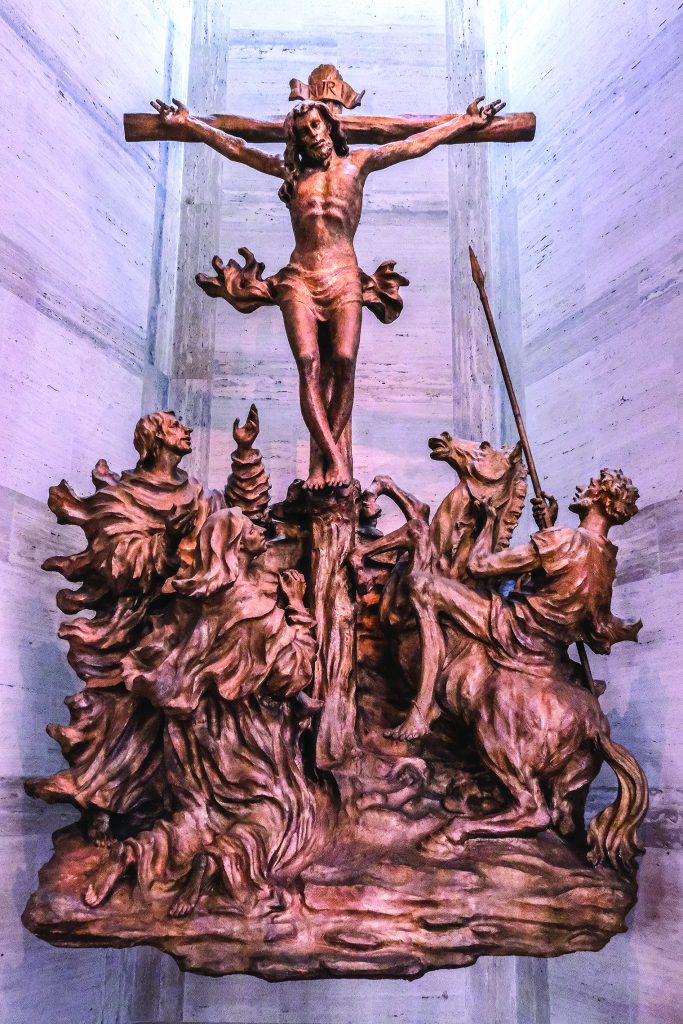
Jn 19: 25-37
This shrine sculpture, also by Rudelli, is a reflection of St. John’s theology linking Jesus’ death and resurrection with the birth of the Church. He captures this by portraying the death of Jesus in the context of victory through resurrection. No nails hold the feet of Jesus to the cross, and no crown of thorns appear on his head, a hint that liberation from death has already begun. A soldier is poised on horseback, ready to pierce the side of Jesus, from which blood and water will pour forth, a symbol of the sacramental life of the Church.
From the plaque: “At the foot of the cross stand Mary and the beloved disciple. The dying Jesus brings into existence a new family.”
The Pentecost
Acts 2: 1-47
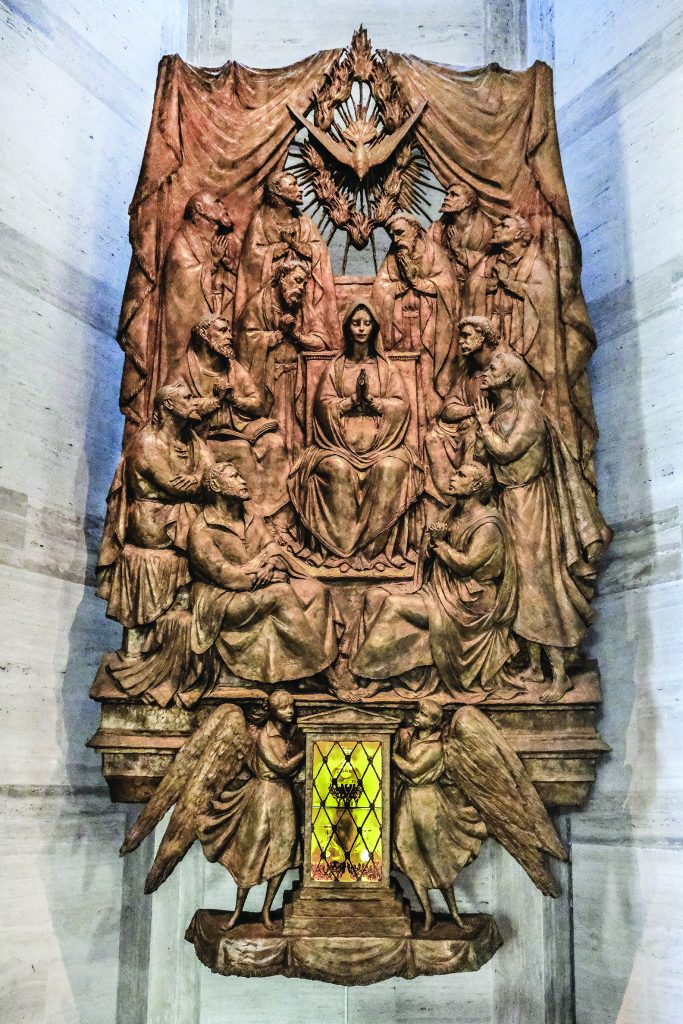
After Jesus’ ascension to heaven, Mary and others of the first Christian community receive the promised gift of the Holy Spirit at the Pentecost. Flames dart out from the Holy Spirit, symbolized by a dove, and rest upon the heads of Mary and the Twelve Apostles, thus commissioning them to preach the Gospel to all nations. Built into this sculpture is a glass case that holds the holy oils blessed in the cathedral at the annual chrism Mass. The oils are used throughout the archdiocese to anoint candidates for baptism, confirmation, holy orders and in the anointing the sick. Interesting note: the angels seen on either side of the holy oils are modeled on Manfrini’s grandchildren.
From the plaque: “The holy oils contained here, when used in sacramental anointing, are visible signs of the strengthening, healing and sanctifying power of the Holy Spirit.”
The Assumption
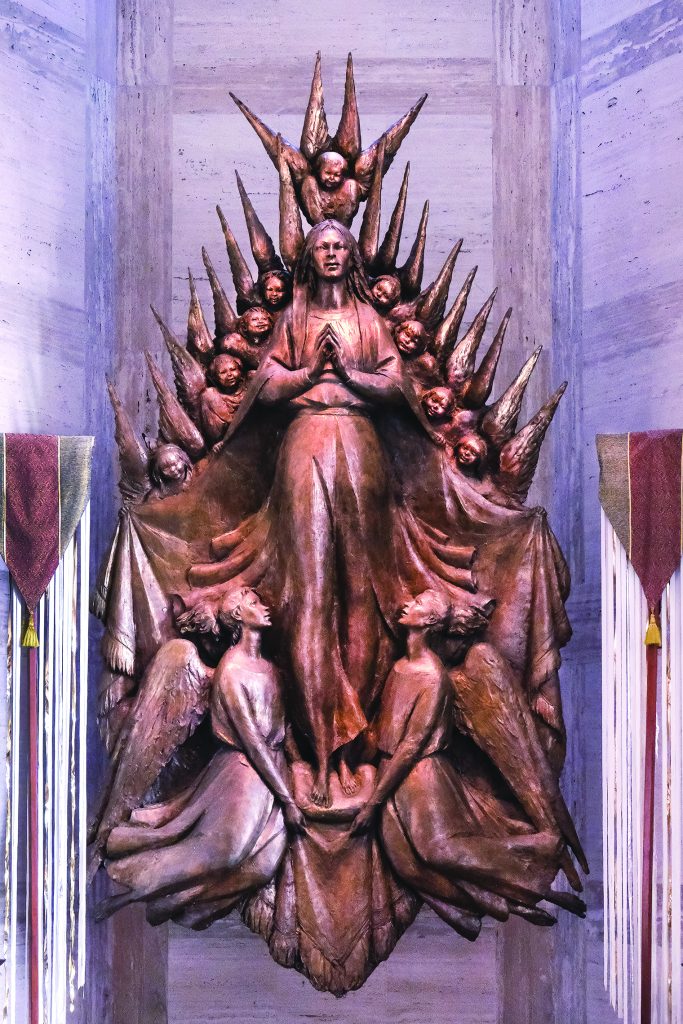
Though last in this sequence of shrines, the Assumption shrine was the first shrine for which Manfrini was commissioned for the new cathedral of the same name. While not recorded in Scripture, the tradition that Mary shares in the victory of her son in both body and soul is found indirectly in the First Letter to the Corinthians (15: 22-24) and other Scripture passages. In this shrine, the artist conveys the rewards of Mary’s discipleship as angels carry her bodily into the glory of heaven. Mary’s Assumption offers a sign of hope to the pilgrim Church on earth.
From the plaque: “We believe that by taking up our cross and following Jesus, we too will receive from him the crown of eternal life.”

